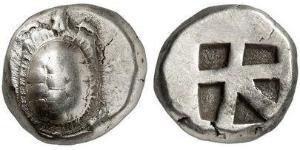[ 2893] KINGDOM of CAPPADOCIA - ARIOBARZANES I, PHILOROMAIOS: 95 - 63 B.C. Silver Drachm (19mm,4.19gm.), 82 B.C. Reference: BMC 20.39, 5. Middle aged diademed head right. Athena standing left holding Nike right, spear and shield on right, crowning the king's name. Regnal year IΔ(=year 14=82/1BC). ΒΑΣΙΛΕΩΣ, on left; ΑΡΙΟΒΑΡΖΑΝΟΥ; ΦΙΛΝΡΩΜΑΙОΥ/Γ in field to left. Provided with certificate of authenticity. CERTIFIED AUTHENTIC by Sergey Nechayev, PhD - Numismatic Expert Ariobarzanes I, named Philoromaios was the king of Cappadocia from 95 BC to ca. 63 BC–62 BC. Ariobarzanes I was a Cappadocian nobleman of obscure origins who was of Persian descent. Ariobarzanes I was originally put in place by the citizens vote of Cappadocia after the Roman Senate rejected the claims of Ariarathes IX of Cappadocia and was supported by the Roman consul Lucius Cornelius Sulla. He was in control on and off of a kingdom that was considered a Roman protectorate and he was removed three separate times by King Tigranes the Great of Armenia before not only securing but actually increasing his lands under general Pompey in the Third Mithridatic War. He eventually abdicated, making way for the rule of his son Ariobarzanes II of Cappadocia in ca. 63 BC–62 BC. Ariobarzanes I married a Greek woman, whom he had as his queen a noblewoman called Athenais Philostorgos I. Athenais bore Ariobarzanes I two children, a son, Ariobarzanes II who succeeded him and a daughter, Isias Philostorgos who married the King Antiochus I Theos of Commagene. Cappadocia is a historical region in Central Anatolia, largely in Nevşehir Province. In the time of Herodotus, the Cappadocians were reported as occupying the whole region from Mount Taurus to the vicinity of the Euxine (Black Sea). Cappadocia, in this sense, was bounded in the south by the chain of the Taurus Mountains that separate it from Cilicia, to the east by the upper Euphrates and the Armenian Highland, to the north by Pontus, and to the west by Lycaonia and eastern Galatia. The name was traditionally used in Christian sources throughout history and is still widely used as an international tourism concept to define a region of exceptional natural wonders, in particular characterized by fairy chimneys and a unique historical and cultural heritage. The term, as used in tourism, roughly corresponds to present-day Nevşehir Province. Etymology - The earliest record of the name of Cappadocia dates from the late 6th century BC, when it appears in the trilingual inscriptions of two early Achaemenid kings, Darius I and Xerxes, as one of the countries (Old Persian dahyu-) of the Persian Empire. In these lists of countries, the Old Persian name is Katpatuka, clearly not a native Persian name. The Elamite and Akkadian language versions of the inscriptions contain a similar name from Akkadian katpa "side" (cf. Heb katef) and a chief or ancestor's name, Tuka. Herodotus tells us that the name of the Cappadocians was applied to them by the Persians, while they were termed by the Greeks as "Syrians" or "White Syrians" (Leucosyri). One of the Cappadocian tribes he mentions is the Moschoi, associated by Flavius Josephus with the biblical figure Meshech, son of Japheth: "and the Mosocheni were founded by Mosoch; now they are Cappadocians". AotJ I:6. Also see Ketubot 13:11 in the Mishna. Cappadocia is also mentioned in the biblical account given in the book of Acts 2:9. The Cappadocians were named as one group hearing the Gospel account from Galileans in their own language on the day of Pentecost shortly after the resurrection of Jesus Christ. Acts 2:5 seems to suggest that the Cappadocians in this account were "God-fearing Jews". See Acts of the Apostles. Under the later kings of the Persian Empire, the Cappadocians were divided into two satrapies, or governments, with one comprising the central and inland portion, to which the name of Cappadocia continued to be applied b ...
Mehr...

|
Beigetragen von:
anonymous 2015-08-19 |
Similar Coin Groups

1 Tetradrachm Antikes Griechenland (1100 ...
Diese Gruppe hat 12 Münzen / 12 Preise
Add coin to this group

1 Stater Antikes Griechenland (1100BC-33 ...
Diese Gruppe hat 16 Münzen / 6 Preise
Add coin to this group

2 Real Vizekönigreich Neuspanien (1519 - ...
Diese Gruppe hat 7 Münzen / 7 Preise
Add coin to this group

1 Tetradrachm Artaxiad dynasty (190BC - ...
Diese Gruppe hat 56 Münzen / 3 Preise
Add coin to this group
2025-05-25
- Historical Coin Prices
2025-05-24
- Historical Coin Prices
Das könnte Sie auch interessieren:

















